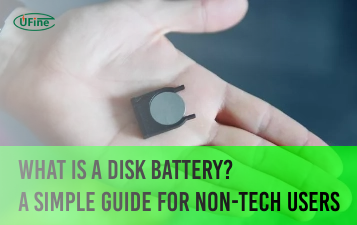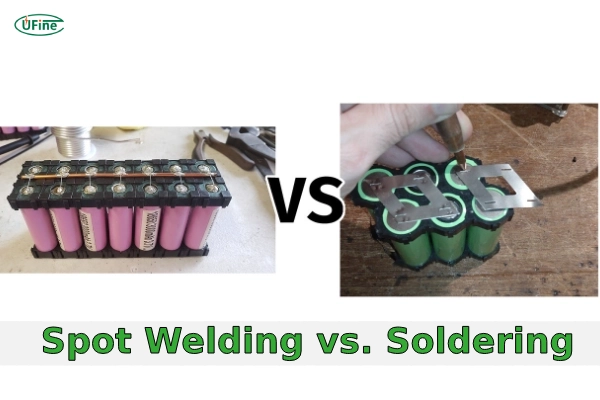What is battery spot welding? Battery spot welding is a fast and efficient technique that uses heat and pressure to connect lithium battery components, creating durable bonds with minimal heat impact. Compared to soldering, spot welding offers advantages for large-scale production and high-reliability applications. Keep reading to discover which method suits your project best.
What’s the dissimilarity between spot welding and soldering lithium batteries? In spot welding, intense heat and pressure join the batteries. Meanwhile, soldering involves melting a metal alloy to create the bond. How do these methods differ? Let’s explore the disparities and considerations for selecting the appropriate technique.
Part 1. Spot welding lithium batteries
What is Spot Welding?
Spot welding is a technique used to combine various lithium battery components. It uses electrical current to create a localized heat source, which melts and fuses the joined materials. Manufacturers commonly use this process in battery assembly due to its efficiency and effectiveness in building strong bonds.
Spot Welding Process
- Equipment: Spot welding machines have electrodes that apply pressure and conduct electricity to the battery components.
- Preparation: The battery components are cleaned and aligned before welding to ensure proper connection.
- Execution: We position the electrodes on either side of the components, then apply a high-current pulse to melt the materials and create a bond.
- Quality Control: Inspection of welds is essential to ensure the integrity and reliability of the battery pack.
How to Spot Weld Lithium Batteries?
Advantages and Limitations of Spot Welding
Advantages:
- Speed: Spot welding is a rapid process suitable for high-volume production.
- Reliability: When performed correctly, spot welds provide strong and durable connections.
- Minimal Heat: Unlike other welding methods, spot welding generates minimal heat, reducing the risk of damaging sensitive battery components.
Limitations:
- Equipment Cost: Spot welding machines can be expensive to purchase and maintain.
- Skill Requirement: Proper execution of spot welding requires training and expertise to ensure consistent quality.
- Accessibility: Spot welding may not be suitable for joining components in hard-to-reach areas of the battery pack.
Part 2. Soldering lithium batteries
What is Soldering?
Soldering is a technique used to join components of lithium batteries by melting a filler metal, known as solder, and applying it to the connection point. This method provides an alternative to spot welding, offering different benefits and considerations.
Soldering Process
- Equipment: Soldering requires a soldering iron, solder wire, flux, and other tools for preparation and application.
- Preparation: We clean the battery components and may apply flux to promote adhesion.
- Application: The soldering iron is heated, and the solder wire is melted onto the joint, creating a bond as it solidifies.
- Cooling: The joint can cool and solidify fully after soldering before further handling.
Advantages and Limitations of Soldering
Advantages:
- Ease of Use: Many people consider soldering easier to learn and perform than spot welding, making it accessible to a broader range of users.
- Flexibility: Soldering allows for more flexibility in joining components, as it can reach areas that may be difficult to access with spot welding.
- Low Heat Impact: Unlike spot welding, soldering generates less heat during the process, reducing the risk of thermal stress and damage to sensitive battery components.
Limitations:
- Thermal Stress: Soldering can still subject the battery components to some degree of thermal stress, mainly if not performed correctly or if excessive heat is applied.
- Component Damage: Improper soldering technique or excessive heat can damage the battery components, reducing performance or safety risks.
- Skill Requirement: While soldering may be easier to learn initially, achieving consistently high-quality solder joints requires practice and skill development.
Part 3. Comparison between spot welding and soldering lithium batteries
When joining lithium battery components, manufacturers commonly use spot welding and soldering methods, each with advantages and limitations. Let’s delve into the comparison between these two techniques:
1. Speed and Efficiency
- Spot Welding: Due to its ability to create strong bonds quickly, manufacturers often prefer spot welding for high-volume production, thanks to its rapid process.
- Soldering: Soldering may take slightly longer than spot welding, as it involves melting solder onto the joint. Still, it offers more flexibility in terms of accessibility and ease of use.
2. Strength and Reliability
- Spot Welding: Spot welds generally provide strong and durable connections, making them suitable for applications where reliability is paramount.
- Soldering: While soldered joints can also be vital if performed correctly, they may not be as robust as spot welds and can be more susceptible to mechanical stress.
3. Heat Generation
- Spot Welding: Spot welding generates minimal heat during the process, reducing the risk of thermal stress to the battery components.
- Soldering: Soldering involves the application of heat to melt the solder, which can potentially subject the battery components to thermal stress if not carefully controlled.
4. Accessibility and Flexibility
- Spot Welding: Spot welding requires electrodes to be positioned directly on the joint, which may limit accessibility in specific configurations.
- Soldering: Soldering offers more flexibility in reaching difficult-to-access areas, making it suitable for joining components in complex battery pack designs.
5. Skill Requirement
- Spot Welding: While individuals require training and expertise to ensure proper execution and quality control in spot welding, they can master it with practice.
- Soldering: Many people generally consider soldering easier to learn and perform than spot welding, as it requires less specialized training and equipment.
6. Suitability for Battery Applications
- Spot Welding: Commonly used in large-scale battery manufacturing due to its speed and reliability.
- Soldering: Often preferred for smaller-scale production or custom battery designs where flexibility and accessibility are crucial.
| Aspect | Battery Spot Welding | Soldering |
|---|---|---|
| Process Speed | Very fast, suitable for high-volume production | Slower, better for custom or small-scale projects |
| Bond Strength | Highly durable and reliable | Moderate, can weaken under mechanical stress |
| Heat Impact | Minimal, reducing damage to sensitive components | Higher heat impact, requires careful control |
| Cost | Higher initial investment for equipment | Lower equipment cost, accessible for hobbyists |
| Flexibility | Limited to accessible joints | Can reach intricate and hard-to-access areas |
Part 4. Considerations for choosing the right method
1. Production Volume
- Large-Scale Production: Spot welding may be more suitable due to its speed and efficiency if you manufacture high-volume lithium batteries.
- Small-Scale Production: For smaller production runs or custom designs, soldering offers greater flexibility and may be more cost-effective.
2. Design Complexity
- Intricate Designs: If your battery design involves intricate components or hard-to-reach areas, you may prefer soldering for its accessibility and flexibility.
- Simple Designs: For straightforward battery designs with easily accessible connection points, spot welding may suffice and offer quicker assembly.
3. Skill Level and Training
- Expertise: Spot welding requires specialized training and expertise to ensure consistent quality welds.
- Ease of Learning: Soldering is generally easier to learn and perform, making it suitable for those with minimal welding experience.
4. Equipment Cost and Maintenance
- Initial Investment: Spot welding equipment can be expensive but may offer long-term savings for large-scale operations.
- Affordability: Soldering equipment is generally more affordable, making it accessible to smaller businesses or hobbyists.
5. Heat Sensitivity of Components
- Temperature Sensitivity: Consider the heat tolerance of your battery components when choosing between spot welding and soldering.
- Minimizing Heat Impact: If your components are sensitive to heat, spot welding’s lower heat output may be preferable to soldering.
6. Quality and Reliability Requirements
- Durability: Assess the durability and reliability requirements of your battery application.
- Quality Control: Consider which method allows for more accessible quality control and inspection to ensure the integrity of the battery assembly.
7. Regulatory Compliance and Safety
- Safety Standards: Ensure your welding method complies with relevant safety regulations and standards.
- Risk Assessment: Evaluate potential risks of each method, such as thermal stress or mechanical damage to battery components.
8. Future Scalability and Adaptability
- Scalability: Consider how easily your welding method can scale with future production demands.
- Adaptability: Assess whether your chosen method allows easy adaptation to changes in battery design or manufacturing processes.
Part 5. Final words
When deciding between spot welding and soldering for lithium battery assembly, consider factors like production volume, design complexity, skill level, equipment cost, component sensitivity, safety, and scalability. You can choose your manufacturing needs best by weighing these considerations.
Part 6. FAQs
-
Is spot welding better than soldering for lithium batteries?
Spot welding is generally better for large-scale production and offers strong, reliable bonds with minimal heat impact. Soldering is ideal for small-scale projects or custom designs. -
What equipment is needed for battery spot welding?
You need a spot welding machine with electrodes, proper alignment tools, and quality inspection equipment to ensure strong welds. -
Can I use soldering for all lithium battery connections?
Soldering is suitable for intricate designs or areas where spot welding cannot reach, but it may not provide the same strength and reliability as spot welding. -
Can spot welding be used for all battery sizes?
Spot welding is suitable for most battery sizes, especially cylindrical and prismatic cells. However, the equipment and settings must be adjusted to accommodate different sizes and materials. -
What are the limitations of soldering for lithium batteries?
Soldering may introduce excessive heat to the battery, potentially damaging it. Additionally, solder joints are less mechanically robust compared to spot welds, making them less ideal for high-stress applications.
Related Tags:
More Articles

What Is a Disk Battery? A Simple Guide for Non-Tech Users
A disk battery is a small, round cell used in watches, remotes, and other electronic devices. It delivers steady power for compact, low-drain devices.
What Battery Powers a Space Heater?
Discover the type of battery that powers space heaters and learn how to choose the right one for efficient heating in your home or office.
What Is an LR14 Battery? Learn About This C-Size Cell
The LR14 battery, also known as a C battery, delivers steady power. Learn its specs, uses, lifespan, and how it compares to other battery types.
Watch Battery Dimensions Chart: Sizes, Voltages, and Equivalents Explained
Understanding watch battery dimensions helps you choose the right size, voltage, and equivalent model to keep your watch running safely and smoothly.
How Long Can You Rely on Battery-Powered Generators?
Discover battery generator runtime & lifespan factors. Learn how to maximize performance and choose the right power solution.




